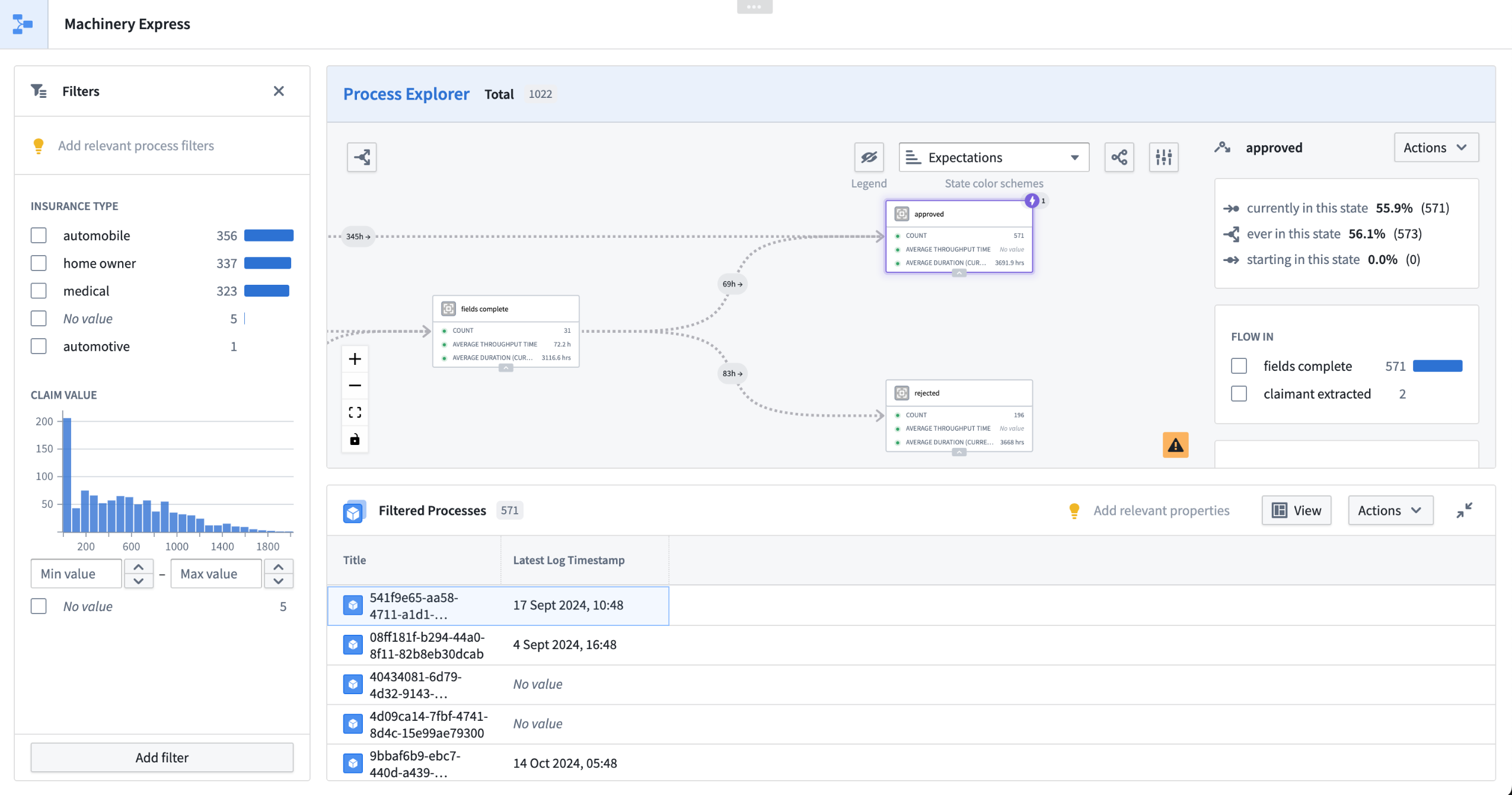Operationalize process optimization
When fully configured, Machinery processes can be integrated into operational applications using dedicated widgets in Workshop. While the Machinery application allows process definition, the Machinery widgets support analysis, operations, and human-in-the-loop workflows for real-time process optimization.
The widget currently supports only a single root process container in the selected Machinery resource. This means no support for siblings or hierarchy. If you have nested containers, they will not be shown.
Machinery's process optimization can be enhanced further by integration with AIP Logic to enable actions backed by LLM responses.
The process log object type, managed by Machinery, responds to changes in the process objects asynchronously. As a result, there may be a slight delay in registering events, and metrics related to historical events might not include the most recent event data.
The two main uses of the widgets are:
- Build unique custom applications for users to manage agentic workflows and advance processes in real-time.
- Analyze processes and identify bottlenecks by drilling down into a rich set of historical performance metrics.
There are two ways to integrate a Machinery process with Workshop, as detailed in the following sections:
- Build a Machinery Express Workshop application: A fast one-click way to kickstart your application development with your Machinery process embedded.
- Incorporate your process into Workshop with the Machinery Process Overview widget: Integrate your process into an existing or new Workshop application.
Build a Machinery Express application
From the Machinery application, you can generate a Machinery Express Workshop application that serves as a ready-to-use analysis tool which can additionally be customized for your specific needs. You can use Machinery Express to share a process immediately with operational users.

To automatically generate a Machinery Express Workshop application based on your process, open your Machinery resource and access the Workshop modules dropdown menu located inline with resource name, then select + Create module.

From the generated module, you can review your existing processes and then navigate back to the Machinery application to reconfigure or optimize your processes over time.
Machinery Process Overview Workshop widget
For a more manual approach, you can create a Machinery Process Overview widget in a new or existing Workshop application to view your process. Choose the Machinery resource that contains the process you want to visualize. The Ontology configuration, as well as the node positions, will be discovered from that process.
Input data
The Machinery Process Overview widget displays a specific set of process objects. You can supply these objects through a Workshop object set variable. To ensure consistency, you should obtain the variable for process log object set through a search-around from the process object set.
By default, last updated at refers to the timestamp of the most recent log entry for each process object. You can choose to maintain an Updated at property on the process object type yourself if you wish to manually specify the timestamp.
Node metrics
The Machinery Process Overview widget computes a set of default metrics based on the latest state and the time it entered that state. To understand the behavior of your process objects, you can add context from other properties. You can define numerical metrics based on all properties of the process and the log object types in the Custom Metrics section.
Node and edge styling
In the node and edge styling sections, you can define the physical appearance of the process for your users.
Graph output
You can use the Machinery Process Overview widget to control other parts of your Workshop application. User interactions on the graph can either control an object set filter or a string-type variable containing the ID of the selected element.
Live mining
Generally, you should first establish an abstract process definition, and then match the observed data against it. However, if your primary aim is to understand your log data and the journey of process entities, it might be premature to define the process in Machinery. For this scenario, Machinery offers live mining: the ability to construct a process definition from your operational data in real time.
To enable live mining, open the Machinery widget configuration in Workshop's Edit mode and toggle the option on. When live mining is enabled, Machinery will identify all states and transitions present in the log object set variable that you provide and lay out the resulting nodes. You can filter this object set to explore subsets of your data and observe in real time the processes formed by these objects.
Process definitions mined live are not saved permanently. You can adjust node positions on the canvas, but the positions will reset when the log object set changes.